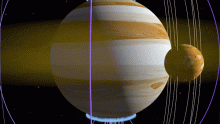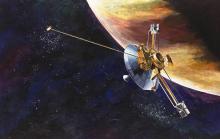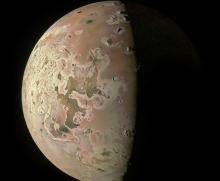Listen to today's episode of StarDate on the web the same day it airs in high-quality streaming audio without any extra ads or announcements. Choose a $8 one-month pass, or listen every day for a year for just $30.
You are here
Mars and Jupiter
Two planetary neighbors will get especially neighborly over the next few mornings. They’ll huddle as close as half a degree from each other — less than the width of a pencil held at arm’s length.
The planets are low in the eastern sky at dawn. The brighter one is Jupiter, the giant of the solar system. Only the Moon and Venus shine brighter. The other world is Mars. It’s close to the lower right of Jupiter tomorrow, and even closer on Sunday. It shines with an orange glow, so it’s hard to miss.
Jupiter might have had a big influence on Mars’s formation.
Today, Jupiter is almost half a billion miles from the Sun — more than three times Mars’s distance. But there’s evidence that when the solar system was young, Jupiter might have moved much closer to the Sun — pretty close to the present-day location of Mars.
The evidence includes Mars itself. The planet is only about half the size of Earth — smaller than it should be. It’s possible that it was kept smaller by Jupiter. As it moved inward, the giant planet would have swept away the small chunks of ice and rock that coalesced to form planets. That would have locked Mars at its current size.
Jupiter’s migration also scattered material between itself and Mars, preventing the birth of another planet — and forming the asteroid belt.
Mars and Jupiter will remain fairly close for a few more days. After that, Jupiter will pull away, leaving Mars behind.
Script by Damond Benningfield






